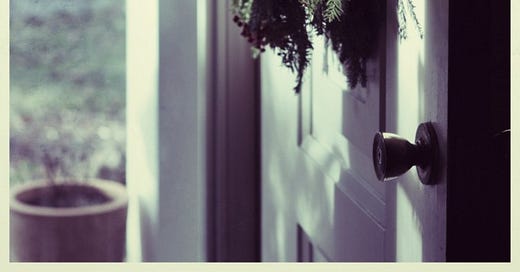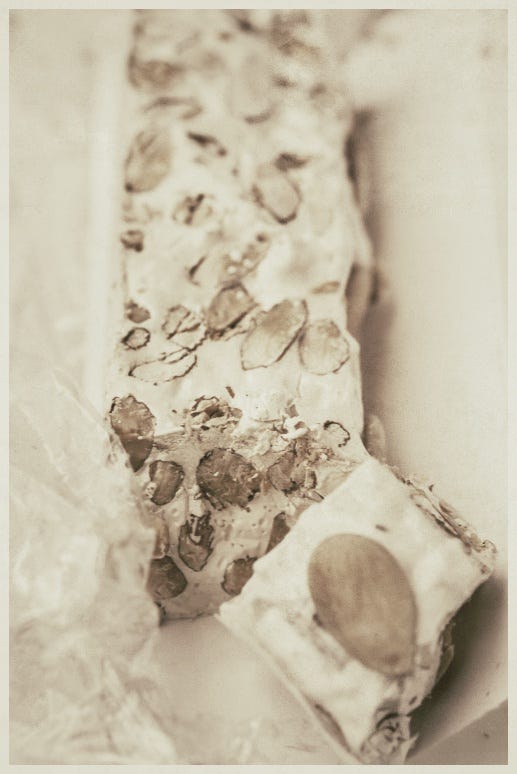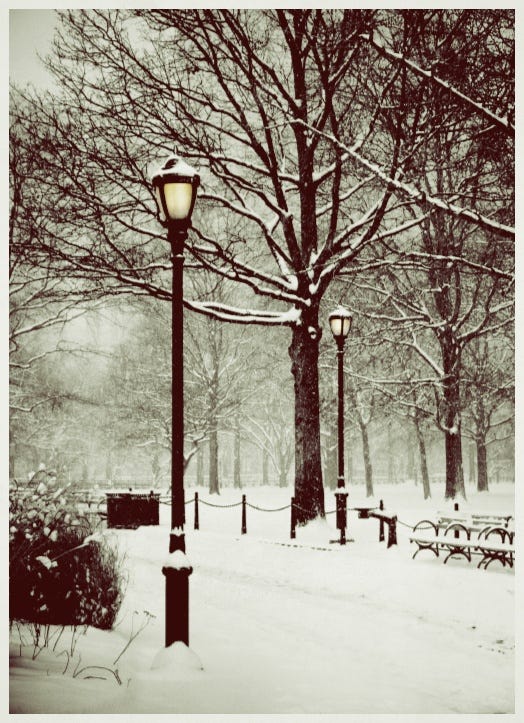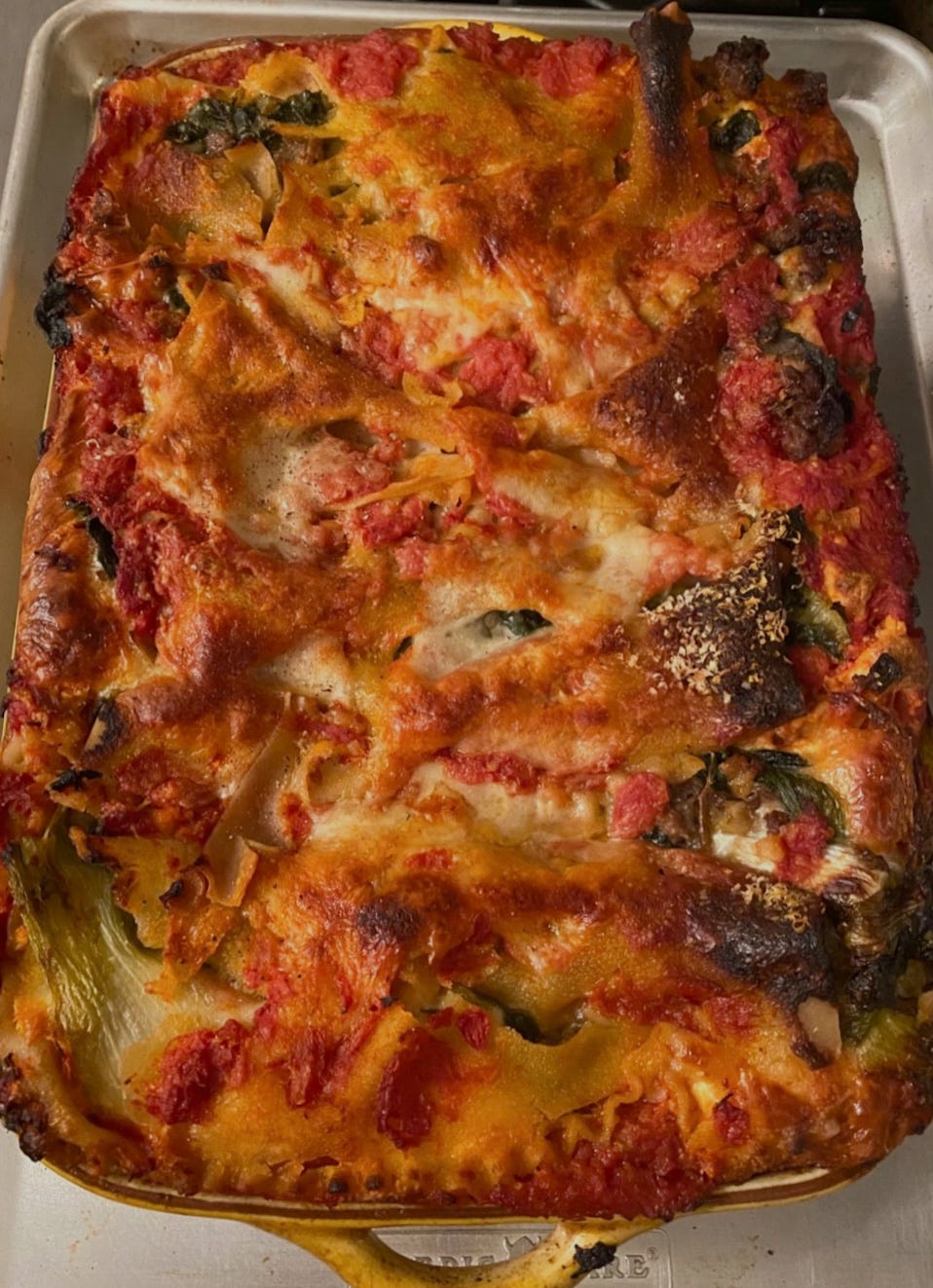Every night, there is another celebrity Christmas special to watch: The Osmond Brothers, wearing shearling coats like the one my father had from his dude ranch days, sing carols from Temple Square in Salt Lake City, enormous flakes of snow settling down on their thick, gorgeous, Mormon eyelashes. John Denver, wearing a metallic silver, yoke-front, western-style shirt sings Merry Christmas Little Zachary, a song to his new baby boy, from inside a heated glass geodesic dome atop a mountain in Aspen, while Annie Denver and a passel of their hippie EST friends watch contemplatively through matching round granny glasses. There are The Waltons, the father of whom is forever getting stranded in a freak snow storm high atop Walton’s Mountain, leaving Livvy Walton, and the children, and Grandma and Grandpa worried sick --- too worried, even, to sit down at their massive farmhouse table laden with the gifts of the season that Livvy bought with spare change hoarded all year in her apron pocket, and then hidden in a blue glass Mason jar in the midst of The Great Depression. There’s the Andy Williams Christmas show, and The Partridge Family, The Brady Bunch, The Carpenters, Bob Hope, and Dean Martin, who sings Ave Maria. There’s Perry Como, who my mother swoons over, and when Bing Crosby sings The Little Drummer Boy with David Bowie, I yell for Gaga, my grandmother, who is frying latkes in our kitchen.
She comes running down the hallway, nearly tripping over the dog, and her eyes grow misty when she sees the rocker and the crooner --- Bing in a blue golf sweater, Bowie in a tight shirt and sport jacket, a massive gold cross dangling around his neck as though he needs to convince viewers of his devotion --- standing on a dark, muted set decorated demurely, like an empty parish house attached to a very old church: no glamorous, kicking Rockettes dressed like snowflakes, or camels or sheep or Wise Men. Instead, a piano, and a Gothic window behind the two singers; fake snow might be gently falling in the fake backlot woods outside.
Sweet, yeasty clouds of hot, baking panettone — the ripe, pungent souring of the biga, the apricots and raisins and Fiori di Sicilia — billow from beneath her neighbors’ doors.
My favorite song, Gaga says, wistfully, standing over me in my bedroom with a Teflon spatula in one hand and an oily kitchen towel in the other, as we watch the little Sony Trinitron television that my parents have given me for Hanukah. She begins to hum along in her low, guttural mezzo-soprano with one of the weirdest duets ever assembled for modern television, between a 1940s movie star with a strong religious, right wing streak and an emerging history of brutality against his vast brood of lilywhite children, and a space oddity named Ziggy Stardust.
Gaga loves this song; she’s loved it since she first heard it on her kitchen radio in the late 1950s, when my mother was out of the house and singing on network television, and Gaga was home alone while my grandfather was working at his Grand Street furniture store, supplying most of south Williamsburg with beds, chairs, desks, tables, and the rest of the mundanity of life. Here, in the third floor apartment that Gaga shares with her husband and daughter, where they have lived since long before the war, I imagine her sitting in the kitchen, turning the amber nobs on the old burled walnut RCA wooden radio that used to stand in the living room --- replaced by the General Electric console television they bought when my mother began appearing on The Galen Drake Show --- and tuning in a local station playing popular music. It’s Christmastime, and her Italian neighbors who live both upstairs and downstairs have decorated their windows with wreaths and tinsel, and tied balsam roping around the banister from the ground floor all the way up to the roof. Sweet, yeasty clouds of hot, baking panettone – the ripe, pungent souring of the biga, the apricots and raisins and Fiori di Sicilia --- billow from beneath her neighbors’ doors, and Mrs. Lambiazi, who lives two flights below her, comes up to borrow extra egg whites for the Torrone she’s making for her son, who is coming in from Providence with his new wife and baby. By the 24th, Gaga tells me thirty years later, the building will begin to smell like a fish market: her neighbors are making baccala and scampi and fried eel, and there’s so much hocking and pounding and chopping and shouting in Italian going on in every apartment that she turns on the radio to calm her nerves, and sits down at her kitchen table to listen, alone, and hears, for the first time, The Little Drummer Boy.
These are the smells of life and of sustenance, she tells herself, that separate the banal from the joyful. She longs to cook great, vast holiday meals that her family --- her four sisters and their husbands and children, her own daughter and husband --- will love, that they will flock to. But her sisters have scattered, some to Florida, some to Queens, and her daughter is afraid of food --- she sold the sandwiches that she carried with her to school, and starved herself to lose weight so that she could be on television --- and her husband, who can’t keep weight on no matter what she feeds him, treats it like the fuel he pumps into his Plymouth. So Gaga makes her weekly chicken soup, and her weekly blintzes, and her weekly brisket as though it's nothing more than a chore, and it is eaten --- if it is eaten at all --- mechanically, angrily, on-the-run, entirely without pleasure.
These are the smells of life and of sustenance, she tells herself, that separate the banal from the joyful.
Christmastime swirls around Gaga, and it sucks her in; over the years, she’s come to love it, to live vicariously through the goodness of it, through the noise and the food and the psychic heart nourishment that she so desperately yearns for. In Brooklyn, the holiday doesn’t care whether she is Jewish, and neither do her neighbors: Christmas climbs the steps of her apartment building and creeps up into the rattling radiators and into the pipes, and when Mrs. Lambiazi shows up one Christmas Day carrying a sheet of steaming Lasagna Bolognese, meat and cheese together, and Gaga says Thank you but I can’t, Mrs. Lambiazi tells her in Italian that she is now family --- Tu sei la nostra famiglia --- and that it comes from her home, and her heart, and that Gaga must. And so she does.
There are only three Christmas songs that Gaga truly loves and will listen to: White Christmas, because it was written by Irving Berlin, and she loves anything written by Irving Berlin; The Christmas Song, because she loves Nat Cole; and I’ll Be Home for Christmas, which she also loves but can’t get through anymore --- if only in my dreams --- since the morning, fourteen years earlier, when Mrs. Lambiazi got the telegram about her older son who was at Anzio with his battalion. Gaga heard the screaming from two flights up and ran down the stairs to find her neighbor collapsed on the kitchen floor, the radio on, her baccala still simmering in a pan of water on the stove above her.
If only in my dreams Gaga hears, and she has to take off her glasses to wipe her eyes; once she starts, she can’t stop, so deep is her feeling for Mrs. Lambiazi, but really, for her own life and situation, for her longing to feed people, and to fill a house with the kind of warmth and laughter and music she’d had when she was younger and living in her mother’s home on South Fifth Street, before all of her sisters had married and moved out, and she, the eldest at thirty-three, was left behind, and people began to talk.
In Brooklyn, the holiday doesn’t care whether she is Jewish, and neither do her neighbors. When Mrs. Lambiazi shows up one Christmas Day carrying a sheet of steaming Lasagna Bolognese, meat and cheese together, and Gaga says Thank you but I can’t, Mrs. Lambiazi tells her in Italian that she is now family—Tu sei la nostra famiglia—and that it comes from her home, and her heart, and that Gaga must.
The first time Gaga hears The Little Drummer Boy, alone in her Brooklyn apartment, she loves it for its simplicity and its message of peace, and its lack of commercial excess; years later, on this night, in my room in Forest Hills, she sits down on the edge of my bed and together we watch Bing Crosby and David Bowie while her latkes cook in the kitchen down the hall, and all she can think of is Mrs. Lambiazi’s lasagna, and the smells of simmering baccala and balsam roping, and life, and sustenance.
Vegetable Lasagna
My first experience with vegetable lasagna was when I was a junior in college, and regularly took my meals in the university’s vegetarian dining room. There, they served something called East/West Lasagna which lodged in my brain as exactly what vegetarian lasagna should never be. Over the years, I’ve come up with this version, which involves vegetables of contrasting textures: there is fennel, escarole, kale, eggplant, and caramelized onion, cooked ahead of time and layered between blankets of tomato sauce, ricotta, mozzarella, and lasagna noodles. The result is not the damp mush that vegetable lasagna sometimes is, but a combination of flavors packed into what is more a densely cooked torta. One caveat: it takes the better part of an afternoon to prepare everything, assemble the dish and then cook it, unless you buy pre-made sauce, which you could certainly do.
Serves 8-12
Tomato sauce
2 tablespoons extra virgin olive oil
2 cloves garlic, peeled and minced
1 medium onion, peeled and diced
1 medium carrot, shaved and diced
2 stalks celery, diced
1 28-ounce can crushed San Marzano tomatoes
1/4 teaspoon fresh oregano
pinch red pepper flakes
salt and black pepper, to taste
Vegetables
1 large eggplant, thinly sliced length-wise (use a mandoline)
sea salt, to taste
2 medium fennel bulbs, stems and fronds removed and reserved, core removed, outer woody leaves discarded
3 tablespoons extra virgin olive oil, divided
2 medium Spanish onions, peeled and sliced
2 cloves garlic, peeled and minced
1 small bunch escarole, dark green outer and white inner leaves roughly chopped
1 bunch Lacinato kale, leaves stripped off stems, and roughly chopped
Assembly
15 ounces fresh ricotta
1 egg, beaten
16 ounces fresh ricotta
1 tablespoon extra virgin olive oil
Finished sauce (recipe above)
1 pound lasagna noodles (I prefer pre-cooked for ease of use; by all means, use fresh lasagna sheets or fresh noodles if available)
Cooked vegetables (recipe above)
1 pound fresh mozzarella, grated
1/2 cup grated Parmigiana Reggiano
Make the sauce
In a medium saucepan, warm the olive oil over a medium flame until rippling. Add the garlic, lower the heat, and add the onion, carrot, and celery. Cook very slowly over a low flame, about 15 minutes, until the vegetables have softened into a sofritto, stirring frequently to make sure that nothing browns. Stir in the tomatoes, raise the heat slightly, and continue to simmer for 15 minutes, set cover askew on the pan before adding the oregano, red pepper flakes, and salt and pepper. Taste for seasoning, and set aside.
Cook the vegetables
Preheat oven to 300 degrees F.
Sprinkle the eggplant slices with a bit of salt and set them on a cookie rack for 10 minutes. Meanwhile, bring a medium saucepan of water to a boil over medium high heat. Quarter the cored fennel bulbs and simmer them in the water until tender, about 20 minutes. Remove from pan, slice the fennel into 1/2 inch thick slices, and set aside.
Pat the eggplant slices dry on both sides — do not rinse. In a large bowl, toss the eggplant slices with one tablespoon of olive oil, and roast on a sheet pan until just barely golden, about 20 minutes. Remove from pan and set aside.
In a large skillet set over medium heat, warm a second tablespoon of olive oil and add the onion. Cook until the onions begin to turn jammy and golden, about 20 minutes, stirring frequently to prevent burning. Add the garlic cloves, and continue took for another five minutes. Remove the onions, garlic, and their juices to a small bowl and set aside.
In the same skillet, heat the remaining olive oil, add the fennel slices and white escarole leaves, and cook over a low flame for about 10 minutes, until they soften. Add the green leaves and the kale, toss well, and cover. Continue to cook over a low flame until the vegetables are wilted, another five minutes. Remove from the pan and set aside.
Assemble the lasagna
Fold together the ricotta and the egg, and set aside.
In a 9 x 13 inch lasagna pan lightly greased with olive oil, ladle half a cup of tomato sauce into the pan and spread it evenly across the bottom. Place three to four lasagna noodles, or one sheet, on top of the tomato sauce.
Beat the egg into the ricotta. Spread a third of the ricotta mixture on top of the first layer of noodles. Layer on a third of the eggplant slices, a third of the onion and garlic, a third of the fennel and greens. Ladle half cup to a cup of sauce over the vegetables; they shouldn’t be submerged (the amount differs based on the depth of your pan). Sprinkle a third of the mozzarella over the tomato sauce, and set down another layer of noodles.
Repeat two more times. On top of the final layer of noodles, ladle sauce and spread evenly, top with mozzarella and Parmigiana. Loosely cover with lightly greased foil.
Set the lasagna pan on a baking sheet, and place on the oven’s middle rack, and bake for 45 minutes. Remove the foil and continue baking for another 15-20 minutes, until the top is golden brown and bubbling. Carefully insert a knife into the center of the lasagna, to make sure the vegetables are cooked through.
Let rest for 15 minutes before serving.









This slayed me. I totally relate to Gaga's yearning for people, a family, the crowding that seemed oppressive at the time but now seems like the way life should be. What a beautiful tribute, and a memory of all those innocent/oblivious Christmas specials. Thank you Elissa.
Thank you for sharing your memories with me.